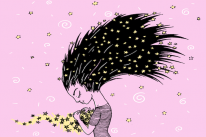
“There isn’t enough room in your mind for both worry and faith. You must decide which one will live there.” ~Sir Robertson
Do you consider yourself a worrier?
Maybe even a perfectionist or Type A personality?
When I’m not at my best, I can be all of those things combined. (Not cute, I know.)
Because of this, I know exactly what it feels like to be stuck in my head, with tightness in my chest and emotional wrenches in my gut.
If you also struggle with worry and anxiety, then I feel you. I rode the worry struggle bus for a long time—until I finally addressed my psychology.
Why Your Psychology Matters Most
My aunt once told me (after I called her in the middle of a freak out), “You’re worried because you’re trying to control the future Kari, and that’s impossible.”
Woah. Paradigm shift. That’s when it all ‘clicked’ and I realized that my issues with worry and anxiety were all self-created.
Then it got me wondering… If I created this worry and anxiety with my thoughts, maybe I can create relaxation with my thoughts too.
After researching the psychology of worry, I learned some practices that helped transition me from an uptight chronic worrier into a pretty relaxed person. I still have my moments, but it’s nothing like before.
Today, I’d like to share three of my best practices with you. I hope they can help you reduce your worry and anxiety too.
Let’s start with the most practical piece of advice.
1. Practice using coping imagery.
This involves visualizing yourself handling worst-case scenarios with confidence.
And just to be clear: You’re visualizing the worst-case scenario, not the best case. It’s like defensive pessimism, which can actually help with anxiety more than positive thinking.
So instead of worrying about being crushed by the worst-case scenario, try visualizing yourself handling it with confidence.
Here’s an example (that I cringe to share with you because it seems so silly in hindsight):
I recently started dating a guy who I developed some serious feelings for. I had the most successful first date of my life with him, and it’s been amazing ever since.
But instead of getting excited about the potential, I started worrying about all the things that could go wrong. (Like I said, being a worrier is self-created misery!)
Specifically, I was worried that in the future we wouldn’t be able to see each other for weeks because he was crazy busy. I grew anxious over feeling devastated in the future by the potential lack of quality time I crave.
Although it wasn’t even a problem yet, I started worrying about making plans to the point where I started sabotaging the romance by “trying too hard.”
I let my anxiety consume me, and I became the chaser instead of allowing something beautiful to naturally unfold. I hated that I started to sabotage something beautiful, but in that moment, (it felt like) I couldn’t help myself.
And this is where the switch happens.
Instead of worrying about how devastated I would feel if we couldn’t spend time together, I started visualizing myself feeling okay if I didn’t get to see him. (I chose “okay” instead of “happy” because it needs to be realistic.)
Instead of thinking about the void, I thought about all the other wonderful things I could do with my time, like surf or entertain my hobbies.
This seriously helped put my mind and body at ease! Here are more details for the process:
How to Do It
To practice using coping imagery, start by imagining the situation that brings you anxiety. How do you feel? What are you thinking?
Then, start to imagine a warm glow of confidence radiating from you. Imagine being in that situation feeling totally confident and capable. How does it feel? What are you thinking?
Then, imagine something going wrong—something that you’re worried about—and imagine yourself handling that situation with confidence and ease too. What thoughts and feelings helped you handle it
Get comfortable with these thoughts and feelings and keep mentally practicing them.
This “mental rehearsal” helps activate neuroplasticity, your brain’s ability to rewire itself and form new neural connections, like new thought loops.
The more you practice using coping imagery, the more you strengthen the new thought loops for positive thinking (or defensive pessimism) and weaken the thought loops for worrying.
In time, you’ll naturally become less of a worrier because your brain has been trained to think confident thoughts instead of worrisome thoughts.
2. Be willing to feel uncomfortable.
Worry and anxiety often come from trying to protect yourself from pain. And I don’t blame you. Our primal brain is wired to seek pleasure and avoid pain; and anxiety is often caused by worrying about the potential pain that we might feel in the future.
Sometimes we’re so afraid of emotional pain and loss that we forget that they can’t physically harm us.
And this is where the saying “make peace with discomfort” will serve you very well, because your ability to be uncomfortable is directly related to your ability to be a relaxed person.
Sometimes we assume that we need to be comfortable in order to be relaxed. But sometimes being relaxed simply means feeling uncomfortable and being okay with that.
The more discomfort you’re able to tolerate, the less you’ll worry about preventing it from happening.
For me, I had to develop the skill of tolerating uncertainty (which is an uncomfortable feeling for me) in my dating life. Although uncertainty feels uncomfortable, I learned to make space for it instead of worrying about making it go away.
If you want to develop the skill of tolerating discomfort too, here’s how you can do it:
How to Do It
A great way to train yourself to tolerate discomfort is to take cold showers. Yup! Even just a five-minute cold shower a day can train your brain to tolerate discomfort.
Not into cold showers? Another great practice is setting aside fifteen minutes every day as your “uncomfortable practice periods.” These practice periods will help you develop the skill of tolerating discomfort.
So whenever you start to feel uncomfortable in your daily life, use it as practice. Hold space for the discomfort and make peace with it as best you can.
For example, if you really hate public speaking, then use your weekly company meeting as a place to practice being uncomfortable by speaking up at least once.
The more you practice feeling uncomfortable, the better you will get at being uncomfortable. And the more uncomfortable you’re willing to be, the less worry and anxiety you will feel.
You’ll learn to let life unfold naturally without worry.
3. Plan what you can and let the rest unfold.
During the months preceding graduation from college I experienced the biggest bout of anxiety and worry that ever consumed me.
What if I don’t get any interviews? What if I totally flunk the interview I get? What if I get the job and hate it? What if, what if, what if?
Fueled by tons of stress, I worked really hard to apply to dozens of jobs before I graduated. In constant panic mode, I refused to leave my desk to play because I was convinced that every ounce of my energy needed to be dedicated to solving this problem.
In the end, I ended up getting a job through a friend who happened to mention the opportunity through random conversation.
I couldn’t have planned for that.
All my preparation paid off, but there was one lesson that I took away from all the unnecessary worry and anxiety:
If I had done everything the same, but did it all in a relaxed fashion, I would have created the same result.
“Let go of the idea that gentle, relaxed people can’t be superachievers… One of the major reasons so many of us remain hurried, frightened, and competitive, and continue to live life as if it were one giant emergency, is our fear that if we were to become more peaceful and loving, we would suddenly stop achieving our goals.” ~Richard Carlson
Sometimes we get tripped up thinking that stress is somehow essential for getting things done. And while some stress is beneficial, extreme stress and anxiety are not necessary for success.
You can be a totally relaxed person and still get everything done—without worry.
How to Do It
Sit down and write down all the things you’re worried/stressed about. Then pretend like you’re coaching someone else with those problems.
What advice would you give them? What steps would you have them take?
Then, follow those steps and stop there. Don’t worry about whether or not you did enough. You followed your own advice, and you can relax about the rest.
Plan what you can, and then breathe. Don’t let your mind continue to race about all the things that could go wrong (unless you’re using Coping Imagery).
Just have faith that what’s meant to be will be, and let the universe carry you for a while.
You’ve Got This
Together, these three steps helped me seriously reduce my anxiety and worry. Will you join me and try them too?
Start by making coping imagery and “uncomfortable practice periods” daily habits. This will help you develop the skill of tolerating discomfort, and your worry and anxiety will lessen.
In time, you will get better at letting life unfold the way it was always meant to be.
Some days you might still find yourself on the worry struggle bus. But maybe this time you’ll feel like you’re in the driver’s seat.
About Kari Dahlgren
Kari Dahlgren is an eating psychology coach specializing in stopping compulsive eating through purely a psycho-spiritual approach, completely free from diet culture. To learn more, follow her eating psychology blog or download her free ebook, The Spiritual Seeker’s Guide to Stop Binge Eating. She loves connecting with readers, so feel free to drop a comment—you’ll always hear back.













 Though I run this site, it is not mine. It's ours. It's not about me. It's about us. Your stories and your wisdom are just as meaningful as mine.
Though I run this site, it is not mine. It's ours. It's not about me. It's about us. Your stories and your wisdom are just as meaningful as mine. 